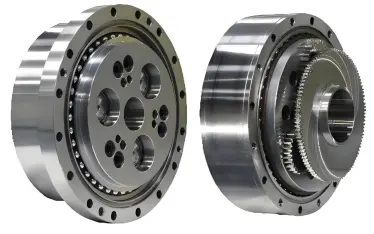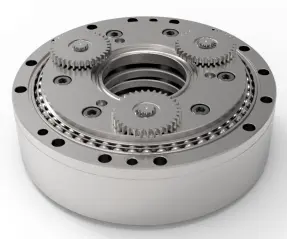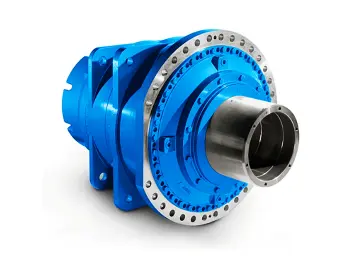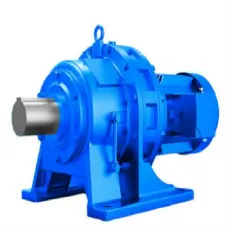
Knowledge
A Comprehensive Guide to the Four Major Reducers
In the fields of automated equipment, industrial robots, and precision machine tools, reducers are like the precise gear hearts, silently transmitting power and precision. Faced with various types of reducers: harmonic, RV, planetary, and cycloidal, how to choose? Who will lead the future? This article analyzes the four major reducer technologies one by one to help you clarify your direction in the selection of technical paths.
I. The Four Kings of Precision Reducers: Core Principles and Feature Comparisons
1. Harmonic Reducer - The Flexible Precision Dance

(1) Core Structure: Composed of a wave generator (input shaft), a flexible gear (elastic steel gear), and a rigid gear.
(2) Operating Mechanism: The wave generator causes the flexible gear to deform radially, achieving transmission through misalignment with the rigid gear.
(3)Technical Advantages: Extremely high transmission ratio (up to 50-160 in a single stage), small size, light weight, excellent precision retention (repeatability < 1 arc-min), and zero backlash transmission.
(4) Application Focus: Robot joints (lightweight collaborative, SCARA robot arms), precision turntables, semiconductor equipment, medical instruments, etc.
(5) Technical Challenges: The fatigue life of the flexible gear material is the core constraint, and thermal deformation and wear issues are significant under high-speed and high-load conditions.
2. RV Reducer - The Heavy-Duty Rigid Giant

(1) Core Structure: Integrates planetary gears and cycloidal pinwheel transmission mechanisms.
(2) Operating Mechanism: The input shaft drives the planetary gears to rotate, causing the cycloidal disk to swing, and achieving variable speed output through pin-to-tooth engagement.
(3) Technical Advantages: Extreme rigidity, high load capacity (extremely strong impact resistance), high precision (backlash < 1 arc-min), long life, and high torsional stiffness.
(4) Application Focus: Industrial robot bases, large arm joints, heavy-load handling scenarios, precision mechanical turrets, high-precision machine tool indexing tables.
(5) Technical Challenges: The design and manufacturing process is extremely complex, with a large number of parts and extremely high assembly precision requirements, making the cost high and difficult to reduce.
3. Planetary Reducer - The Backbone of Power Transmission

(1) Core Structure: Composed of a sun gear, planetary gears (3-4 sets), a planet carrier, and an internal gear ring.
(2) Operating Mechanism: The input power drives the sun gear, and the planetary gears mesh with it to transmit power, which is then integrated and output through the planet carrier.
(3) Technical Advantages: High transmission efficiency, compact structure with excellent rigidity, strong load-sharing ability of multiple gear meshing, high torque density, and modular combination for variable speed.
(4) Application Focus: Industrial automation lines, construction machinery, wind turbine pitch drives, AGV drives, medical imaging equipment, etc.
(1) Technical Challenges: It is difficult to control the accumulation of precision errors in multi-stage transmission, and high-end products are still mainly imported. The performance of core gear materials limits the upper limit of the torque density of the reducer.
4. Cycloidal Reducer - The Expert in Smooth and Efficient Transmission

(1) Core Structure: Relies on the eccentric meshing of the cycloidal disk and the pin gear ring.
(2) Operating Mechanism: The eccentric shaft drives the cycloidal wheel to perform eccentric motion, causing the pins to form continuous meshing motion.
(3) Technical Advantages: High torque density, high efficiency, strong stability, wide range of reduction ratios, low noise, and small vibration.
(4) Application Focus: Crane slewing mechanisms, construction machinery drives, logistics sorting equipment, shield machine cutter head drives, etc.
(5) Technical Challenges: High precision requirements for parts processing, and domestic high-end technology has not yet been fully developed. Its application breadth in high-precision fields is weaker than that of RV and harmonic reducers.
II. Industry Application Panorama: Who Dominates Key Scenarios?
Robotics Field:
Collaborative Robots: Harmonic is dominant (ultra-compact, low-load precision requirements).
Six-axis Industrial Robots: RV is the absolute leader (base and shoulder joints bear critical loads).
SCARA and Delta: Harmonic or planetary are dominant (harmonic is often used for the large arm and Z-axis; planetary is often used for the transmission shaft). Precision Machinery Field:
Precision machine tools: RV (rotary table/indexing) and planetary (spindle indexing) are common options.
Semiconductor equipment: High-precision harmonic reducers are the preferred choice, while low-vibration planetary reducers also have their applications.
Medical surgical systems: Extremely high precision and stability are required, and harmonic reducers are the core technology option.
Industrial Drive and Special Equipment Field:
New energy automation: Planetary reducers with high torque are widely used in wind turbine pitch control; planetary and cycloidal reducers are commonly used in photovoltaic cell transmission.
Heavy-duty applications in construction machinery: Cycloidal, planetary, and RV reducers are all widely used, especially cycloidal reducers in the main drives of large equipment.
AGV drive in logistics systems: Planetary reducers play a crucial role as the main transmission shaft.
III. Technological Frontiers and Development Trends: Who Will Hold the Future Discourse Power?
1. Future Evolution Direction of Harmonic Reducers:
Extended fatigue life: Japan's new structural design (IH tooth profile) has achieved longer life; China is gradually improving product reliability by using new alloy flexible gears and heat treatment processes.
Precision and rigidity upgrade: Research on methods to increase torsional stiffness (such as three-wave generation technology), and optimizing the structure to reduce high-speed thermal deformation.
Miniaturization development: Miniature harmonic reducers (outer diameter ≤ 20mm) are expanding new scenarios for small robots and precision medical devices.
2. Breakthrough Path for RV Reducers:
Intelligent manufacturing breakthrough: Japan holds the absolute discourse power with its precision processing equipment; China is focusing on achieving breakthroughs in domestic high-precision grinding machines and automated assembly lines.
Design model optimization: New topological optimization methods significantly enhance the strength and lightweight level of parts (Shanghai Zhika's new version reduces weight by 10% and increases load capacity by 8%).
Core material improvement: Heat treatment processes and the application of new materials (such as special powder steel) to improve the fatigue resistance of core cycloidal wheels.
3. Future Innovation Areas for Planetary Reducers:
Lightweight and high power density: Precision 3D printing technology enables the integrated manufacturing of planetary gears and complex configuration brackets (such as Siemens' development of printed gears with a density of up to 15wt.% in aluminum-based planetary gears).
High-speed silence and multi-level integration: New gear modification processes and damping technologies effectively reduce noise (such as SEW's X series reducing noise by 3-5dB); integrated design of planetary gear systems and precision bearings saves space.
Intelligent self-detection integration: Utilizing sensors to integrate the operation data of planetary reducers for fault pre-diagnosis (such as Nord's integrated system that can monitor temperature and vibration signals).
4. New Development Points for Cycloidal Reducers:
Structural innovation application: Consolidating the position in heavy-duty non-standard drive fields (such as China's Lick developing super high-torque cycloidal reducers for wind power).
Precision and process leap: Improving the surface treatment process of core parts (grinding accuracy reaching Japanese standards), and enhancing transmission efficiency.
Exploration of engineering composite materials: Progress in the application of engineering plastics in cycloidal reducers under light load conditions (German Kebonit experiments show good performance in medium and low-speed transmission conditions).
IV. Market Pattern Prediction: Who Will Reach the Summit in the Next 3-5 Years?
Short term (1-3 years): RV and harmonic reducers will maintain a duopoly in precision transmission.
Long term (3-5 years):
Multi-directional development of robots: The significant expansion of collaborative robots will trigger a surge in demand for harmonic reducers (expected global market size to exceed 900 million units by 2026); heavy-duty industrial robots will drive the stable growth of RV reducers (annual compound growth rate of nearly 11%).
Diversified upgrade of planetary transmission: Its basic structure has the ability to expand modules, and its potential in automation non-standard drives and new energy fields will continue to be released.
Cycloidal reducers will continue to dominate heavy-duty applications: They remain irreplaceable in special equipment and large load fields. The throne of future reducers will not be monopolized by a single system, but rather, the four major systems will each establish their own moat and develop in a differentiated manner, continuously strengthening their positions.
V. Selection Code: Matching the Optimal Solution Based on Application Scenarios
Load Requirement (N):
N ≤ 50Nm → Harmonic
50Nm < N < 800Nm → RV (for high-precision and rigidity requirements) or Planetary/Worm (for non-high-precision)
N ≥ 800Nm → Planetary or Worm Reducer
Space Dimension Limitation (S):
S is extremely small → Harmonic is the preferred solution
S is limited but needs to carry load → RV is the preferred choice (with the best compact heavy-load capacity)
S is moderately limited → Planetary or some high-end Worm
Precision Requirement (P):
Repeated positioning accuracy ≤ 1 arc minute → Harmonic/RV
P is between 2 and 5 arc minutes → Planetary/Some high-end Worm can meet the requirement
Scenario Budget (B):
Ample budget and pursuit of optimal performance → RV/Harmonic
Cost-sensitive and requires large torque → Planetary or Worm solution
Vigor has more than 20 years of experience in producing castings, forging, and do the related heat treatment processes. If any thing we can help or any parts need to be developed, please feel free to contact us at info@castings-forging.com



